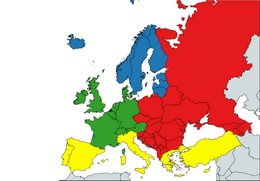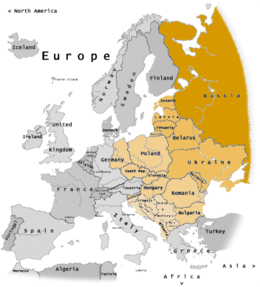
Back أوروبا الوسطى والشرقية Arabic Үҙәк һәм Көнсығыш Европа Bashkir Централна и Източна Европа Bulgarian ئەورووپای ناوەند و ڕۆژھەڵات CKB Střední a východní Evropa Czech Mittel- und osteuropäische Länder German Κεντρική και Ανατολική Ευρώπη Greek Mez-Orienta Eŭropo Esperanto Europa Central y Oriental Spanish Kesk- ja Ida-Euroopa riigid Estonian
Central and Eastern Europe is a geopolitical term encompassing the countries in Northeast Europe (primarily the Baltics), Central Europe, Eastern Europe, and Southeast Europe (primarily the Balkans), usually meaning former communist states from the Eastern Bloc and Warsaw Pact in Europe, as well as from former Yugoslavia. Scholarly literature often uses the abbreviations CEE or CEEC for this term.[1][2][3] The Organisation for Economic Co-operation and Development (OECD) also uses the term "Central and Eastern European Countries" (CEECs) for a group comprising some of these countries. This term is sometimes used as an alternative to the term "Eastern Europe," for more neutral grouping.[4][5][6][7][8]
 Central and Eastern Europe |
 |

- ^ Inotai, András (Autumn 2009). "BUDAPEST—Ghost of Second-Class Status Haunts Central and Eastern Europe". Europe's World. Archived from the original on 2013-01-12. Retrieved 2012-09-04.
- ^ Z. Lerman, C. Csaki, and G. Feder, Agriculture in Transition: Land Policies and Evolving Farm Structures in Post-Soviet Countries, Lexington Books, Lanham, MD (2004), see, e.g., Table 1.1, p. 4.
- ^ J. Swinnen, ed., Political Economy of Agrarian Reform in Central and Eastern Europe, Ashgate, Aldershot (1997).
- ^ Mälksoo, Maria (2019-05-04). "The normative threat of subtle subversion: the return of 'Eastern Europe' as an ontological insecurity trope". Cambridge Review of International Affairs. 32 (3): 365–383. doi:10.1080/09557571.2019.1590314. ISSN 0955-7571. S2CID 159184190.
- ^ Twardzisz, Piotr (2018-04-25). Defining 'Eastern Europe': A Semantic Inquiry into Political Terminology. Springer. p. 18. ISBN 978-3-319-77374-2.
- ^ Hall, Derek (July 1999). "Destination branding, niche marketing and national image projection in Central and Eastern Europe". Journal of Vacation Marketing. 5 (3): 227–237. doi:10.1177/135676679900500303. ISSN 1356-7667. S2CID 154698941.
- ^ Zarycki, Tomasz (2014). Ideologies of Eastness in Central and Eastern Europe. doi:10.4324/9781315819006. ISBN 9781317818571. S2CID 129401740.
- ^ Kalnoky, Boris. "Eastern promise and Western pretension – 09/07/2018". DW. Retrieved 2022-11-16.